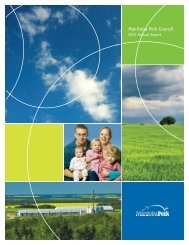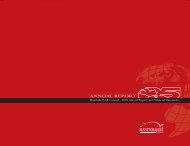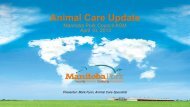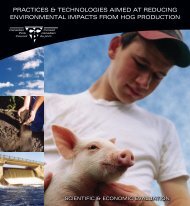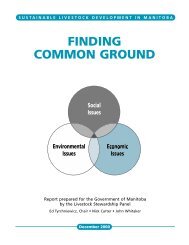Barn Safety - Manitoba Pork Council
Barn Safety - Manitoba Pork Council
Barn Safety - Manitoba Pork Council
Create successful ePaper yourself
Turn your PDF publications into a flip-book with our unique Google optimized e-Paper software.
8<br />
must be kept clear of snow and ice accumulation. Where an overhead accumulation of<br />
snow or ice creates a risk, it must be removed or an overhead barrier designed to withstand<br />
any load that is likely to be imposed on it is installed. Pressure plants and pressure vessels<br />
not subject to The Steam and Pressure Plants Act must be properly constructed, installed,<br />
used, stored, repaired, and maintained in accordance with the manufacturer’s specs. Sign at<br />
construction project site must have the following information must be clearly and<br />
prominently identified on sign located in a conspicuous place at a construction project site:<br />
Name of prime contractor or employer, the location of any first aid service, the name and<br />
telephone number of the person who can be contacted about safety and health matters, and<br />
contact information for the committee and the representative as applicable.<br />
Language Barriers to Effective <strong>Safety</strong> and Health Training<br />
<strong>Manitoba</strong>’s pork industry is attracting increasing numbers of workers from abroad.<br />
Language and literacy differences among workers mean that safety education may<br />
have to be tailored to each individual working in the barn. Make sure all workers<br />
understand your safety and health policies.<br />
<strong>Safety</strong> During Animal Handling<br />
Injuries from animals and animal handling resulted in the second highest number of farmrelated<br />
hospitalizations in <strong>Manitoba</strong> between 1990 and 1995. More worker injuries occur<br />
during direct pig contact than any other part of hog production. Studies have shown that<br />
back and neck injuries and slips and falls seem to be the most common concern for<br />
animal handling related injuries. Less frequent, but equally important injuries include<br />
bites, kicks, cuts, abrasions and needle sticks.





